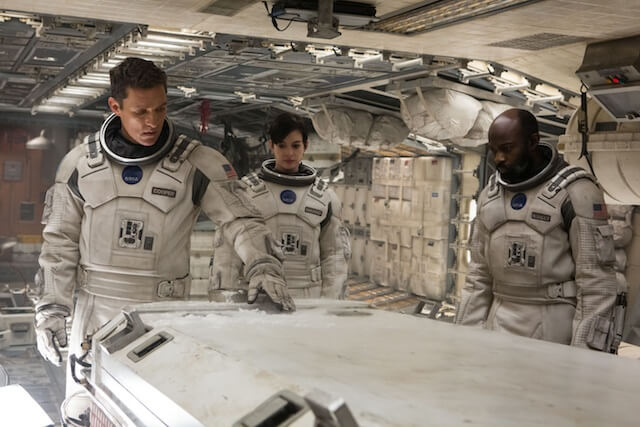Wednesday marks a milestone: A film is being released on film. “Interstellar” hits theaters Wednesday — just not even close to all of them. That may seem odd, given that it’s one of the most highly anticipated movie events of the year: the latest from brainy blockbuster-maker Christopher Nolan, who has sent Oscar winners Matthew McConaughey and Anne Hathaway to space (to meet another, secret Oscar winner). Yet the only theaters getting it are the ones that never threw out their film projectors (and who still have the staff who actually knows how to work these rickety contraptions). Starting today one can see “Interstellar” in good, old-fashioned, grainy and meltable 35mm as well as super-sized 70mm IMAX — but only in th 249 theaters that can show 35mm and 70mm. The rest of the country’s multiplexes — the ones that converted entirely to digital, which is nearly all of them — don’t get it till Friday. This bold move is a strong push-back against the digital wave that has almost entirely consumed modern movie watching. 2010 was the year that DCP (Digital Cinema Package) could really be felt, when most theaters switched — at a great, great cost, especially to mom-and-pop theaters — to a purely computerized system. Instead of bulky, molding, expensive-to-ship film reels, movies were mere files with a password to unlock. Unlike film, they would never scratch, rot or burn up, and all a projectionist had to do was hit a button. Then again, the files could get corrupted or accidentally deleted. The passwords could be lost. (At least with tangible celluloid a resourceful projectionist could find some way of getting it running. Tech issues are a whole other beast.) And while it’s nice to have sparklingly clean images, they can be too clean, too bright. Loving the grain and analogue styles of projected film over DCP isn’t mere snobbery; projected film has a different presence and texture. A piece of film dies a little every time it’s run through a projector, and one can sense a physical presence every time film is flickering on a screen. Digital film is fine and clear and crisp — sometimes to a fault. It can look fake. As Quentin Tarantino — like Nolan, another celluloid zealot — once put it, digital projection is like “watching television in public.” DCP isn’t going anywhere; the studios are committed to digital, even though they have yet to find a reliable way to archive films as computer files, which could easily be corrupted or not be accessible on always changing media players. Still the best way to preserve a film is on film — and film prints are not cheap to make or to store. (As it right now stands, movies are screwed.) But film should be an option too, and grand gestures like this “Interstellar” brouhaha help create film awareness — even if, one could argue, it turns the medium into a William Castle-style gimmick. “Interstellar” indeed looks great on 70mm. Its early scenes on Earth — the film, incidentally, is about McConaughey and Hathaway searching through the cosmos for a planet to replace the dying Earth — are sometimes impossibly dark. But once it gets to space you can not only see the majesty but feel it. None of it looks digital, not even the planets our plucky heroes visit. Nolan shot one of them in Iceland, and it really does resemble an alien land. It looks real — it looks like film. Other filmmakers who still shoot on film
Christopher Nolan isn’t the only one still holding the torch for celluloid. Quentin Tarantino has threatened to quit filmmaking once film is officially defunct. He too will be releasing 70mm prints of his next film, “The Hateful Eight,” and recently bought up Los Angeles’ New Beverly Cinema theater, which he swears will only screen 35mm, no matter how beat up and faded. Two years ago Paul Thomas Anderson’s “The Master” was shipped out in 70mm prints, and his new “Inherent Vice” played the New York Film Festival on 35mm. On the smaller side, Wes Anderson still does film, as does Rian Johnson, who shot “Brick,” “The Brothers Bloom” and “Looper” on film. (He’ll be doing the same for “Star Wars Episode VIII,” even though his boss — one George Lucas — was one of the first majors to embrace film on video.) On the indie side, Alex Ross Perry has never shot on video, although you can’t presently see his latest, the Super 16mm-shot “Listen Up Philip,” projected on film. Stories of when digital fails
Projectionists have mostly gotten the hang of DCP now, but there have been some famous flubs. A critic’s screening of “Marvel’s The Avengers” was delayed about an hour after whoever was running it accidentally deleted the file and had to download a replacement. And two years ago the American premiere screening of Brian De Palma’s “Passion” at the New York Film Festival — with De Palma in attendance amongst a packed house on a Saturday night — was cancelled when the file’s password wouldn’t work. Click here to see what cinemas in NYC are showing “Interstellar” on film.
Click here to see what cinemas in the Boston area are showing “Interstellar” on film.
Click here to see what cinemas in Philly are showing “Interstellar” on film.
Why you should see ‘Interstellar’ projected on film

Melinda Sue Gordon, Paramount, Warner Brothers
Follow Matt Prigge on Twitter@mattprigge


















